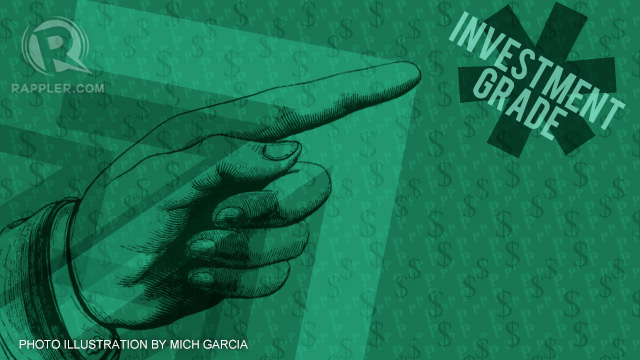SUMMARY
This is AI generated summarization, which may have errors. For context, always refer to the full article.

MANILA, Philippines (2nd UPDATE) – In another vote of confidence for the Philippine economy’s performance under the Aquino administration, international credit rating agency Moody’s Investors Service upgraded the country’s foreign and local bond ratings from Ba2 to Ba1.
This means all 3 major debt rating agencies — Moody’s, Standard & Poor’s (S&P) and Fitch — have the Philippines just one level below investment grade.
Moody’s latest credit upgrade is the 8th for the Philippines since 2010.
An improvement in credit rating translates to lower borrowing costs for the Philippines, which taps global debt markets for funds used to plug budget gaps.
These improved ratings usually trickle down to increased investments in the capital markets, or job-generating manufacturing and service sectors. Investors usually take these upgrades as a sign that prospects for the country are bright.
This recent upgrade comes amid a gloomy economic environment in the United States and Europe where bailouts and austerity measures abound, causing massive job losses and benefit cuts.
“Despite the headwinds from softening external demand, the Philippines has demonstrated considerable economic strength and fiscal resilience,” Moody’s said in a statement on Monday, October 29.
“In contrast to similarly rated countries, the country is poised to record a combination of faster growth, lower inflation, exchange rate appreciation, and an increase in foreign exchange reserves, while maintaining trend debt consolidation,” it added.
Finance Secretary Cesar Purisima was elated by the news. In a text message, he said, “This is another affirmation of the economic agenda of President Aquino…We will continue to focus on the fundamentals of fiscal sustainability, macroeconomic stability and business environment enhancement.”
“This is the only way to growth that is inclusive and sustainable,” Purisima noted.
Reasons for upgrade
Moody’s cited the country’s fiscal health, resilient remittances, infrastructure investments, and the peace deal between the government and Mindanao rebel group in its decision to upgrade the Philippines’ ratings profile.
“Despite the lack of progress in its public-private partnership (PPP) program, the government’s spending on infrastructure has picked up, but its fiscal impact has been mitigated by the continued gains from enhanced revenue administration,” it said.
The government posted a budget deficit of P106.062 billion in the first 9 months of the year, still way below the full-year deficit ceiling of P279 billion in 2012.
“Remittance inflows continue to increase despite the global economic slowdown, which further underscores their role in sustaining private consumption and maintaining a healthy current account surplus,” the rating agency noted.
It was also upbeat about the recently inked peace plan in Mindanao.
“Over the longer term, the landmark peace agreement signed between the government and the Moro Islamic Liberation Front (MILF) may have wider beneficial effects on investment and economic growth in Mindanao–the country’s largest island–which has untapped agricultural and mining potential.”
Monetary policy
Moody’s also cited the Bangko Sentral ng Pilipinas’ (BSP) handling of the monetary environment amid rising inflation rates elsewhere.
The agency said Philippines’ rating continues to be anchored on “macroeconomic stability as reflected in the success of the central bank’s inflation targeting regime.”
In a statement, BSP Governor Amando Tetangco attributed this to “structural reforms that have strengthened the Philippine banking system and have transformed our banks into effective financial intermediaries…over the past two decades”
“This year, BSP has cut policy rates by a total of 100 basis points to help the economy withstand ongoing global economic strains and to support economic growth. Our prudent approach to external financial management has yielded a more manageable and sustainable external debt position,” he added.
Moody’s noted that “taken together, these strengths have contributed to the appreciation of the peso and lower interest rate costs for the government. These have in turn helped accelerate the process of debt consolidation, thus addressing the relatively high stock of debt, a constraint on the Philippine rating.”
Sin tax reforms
Moody’s said it may consider further upgrading the Philippines’ ratings to investment level if the following are pursued:
- the passage and effective implementation of structural revenue reforms
- a more rapid reduction in the general government debt stock
- an acceleration of investment spending that ensures a higher economic growth trajectory
Credit rating officials have long pointed to the reforms in the sin tax structure as a key decision point. The House of Representatives has passed a sin tax bill aiming to raise additional P30 billion in revenues, while the Senate will soon discuss it in plenary.
President Benigno Aquino III has been adamant to have the sin tax reform bill passed before the 2013 elections.
The Philippine economy grew by 6.1% in the first half of this year and the government is hopeful of maintaining that expansion pace throughout 2012. – Rappler.com
Add a comment
How does this make you feel?
There are no comments yet. Add your comment to start the conversation.